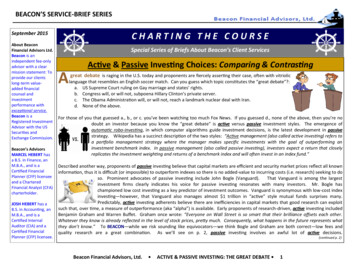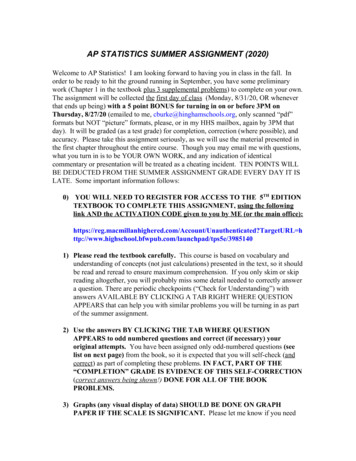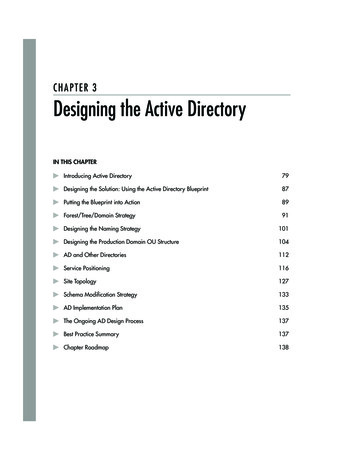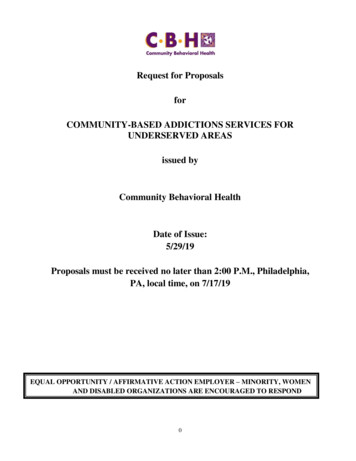
Transcription
BEACON’S SERVICE-BRIEF SERIESSeptember 2015About BeaconFinancial Advisors Ltd.Beacon is anindependent fee-onlyadvisor with a clearmission statement: Toprovide our clientslong-term valueadded financialcounsel andinvestmentperformance withexceptional service.Beacon is aRegistered InvestmentAdvisor with the USSecurities andExchange Commission.Beacon’s AdvisorsMARCEL HEBERT hasa B.S. in Finance, anM.B.A., and is aCertified FinancialPlanner (CFP) licenseeand a CharteredFinancial Analyst (CFA)charterholder.JOSH HEBERT has aB.S. in Accounting, anM.B.A., and is aCertified InternalAuditor (CIA) and aCertified FinancialPlanner (CFP) licensee.CHARTING THE COURSESpecial Series of Briefs About Beacon’s Client ServicesActive & Passive Investing Choices: Comparing & ContrastingAgreat debate is raging in the U.S. today and proponents are fiercely asserting their case, often with vitrioliclanguage that resembles an English soccer match. Can you guess which topic constitutes the “great debate”?:a. US Supreme Court ruling on Gay marriage and states’ rights.b. Congress will, or will not, subpoena Hillary Clinton’s private server.c. The Obama Administration will, or will not, reach a landmark nuclear deal with Iran.d. None of the above.For those of you that guessed a., b., or c. you’ve been watching too much Fox News. If you guessed d., none of the above, then you’re nodoubt an investor because you know the “great debate” is active versus passive investment styles. The emergence ofautomatic robo-investing, in which computer algorithms guide investment decisions, is the latest development in passivestrategy. Wikipedia has a succinct description of the two styles: “Active management (also called active investing) refers toa portfolio management strategy where the manager makes specific investments with the goal of outperforming aninvestment benchmark index. In passive management (also called passive investing), investors expect a return that closelyreplicates the investment weighting and returns of a benchmark index and will often invest in an index fund.”Described another way, proponents of passive investing believe that capital markets are efficient and security market prices reflect all knowninformation, thus it is difficult (or impossible) to outperform indexes so there is no added-value to incurring costs (i.e. research) seeking to doso. Prominent advocates of passive investing include John Bogle (Vanguard).That Vanguard is among the largestinvestment firms clearly indicates his voice for passive investing resonates with many investors. Mr. Bogle haschampioned low cost investing as a key predictor of investment outcomes. Vanguard is synonymous with low-cost indexinvesting—however, that Vanguard also manages almost 1 trillion in “active” style mutual funds surprises many.Predictably, active investing adherents believe there are inefficiencies in capital markets that good research can exploitsuch that, over time, a measure of outperformance (aka “alpha”) is available. Early proponents of research-driven, active investing includedBenjamin Graham and Warren Buffet. Graham once wrote: “Everyone on Wall Street is so smart that their brilliance offsets each other.Whatever they know is already reflected in the level of stock prices, pretty much. Consequently, what happens in the future represents whatthey don’t know.” To BEACON—while we risk sounding like equivocators—we think Bogle and Graham are both correct—low fees andquality research are a great combination. As we’ll see on p. 2, passive investing involves an awful lot of active decisions.(continued p. 2)Beacon Financial Advisors, Ltd. ACTIVE & PASSIVE INVESTING: THE GREAT DEBATE 1
BEACON’S SERVICE-BRIEF SERIESActive & Passive Investing Strategies: Comparing & Contrasting—PASSIVE INVESTING REQUIRES LOTS OF ACTIVE CHOICES“I’m reminded of a gentleman who discovers a genie in a bottle. Granted only one wish—apparently even genies havepricing power—the man asks for peace in the Middle East. The genie backs away and says, “That’s way too difficult. Giveme something easier.” The man ponders his options and asks the genie instead, to help him pick a good mutual fund.The genie quickly responds, “Let me get to work on the Middle East.” Steven Romick, First Pacific Advisors in June 2015 speech to CFA Society ChicagoIn his highly insightful blog of 7/24/14 The Myth of the Passive Investor, AllianceBernstein money manager Patrick Ruden illustrates active choices inpassive investing: -of-the-passive-investorSome investors have such little faith in the merits of active management that they prefer to take a 100% passive approach. We think they may be making more activedecisions than they realize. Those who go passive know why they’re doing it. Instead of paying active managers to try to select securities to beat a particular index,they’ve decided to hire managers to track that index. Yet this approach involves several active choices. First, passive investors must decide how to allocatetheir assets. A US investor, for example, might decide to be 50% in US bonds, 25% in US equities and 25% in international equities. Next, passive investors must choosewhich indices they want tracked. Our US investor might select the Barclays US Aggregate Bond, the S&P 500 and the MSCI EAFE indices respectively. So far, sostraightforward. But getting to this point has required a lot of active decision making. The important decision about how much to allocate to bonds versus equitiesis an active choice. And so is the decision about how much to allocate to US versus non-US stocks.Who decides what? In the case of US equities, by choosing the S&P 500 as the index to track, our investor has outsourced stock selection decision making to theS&P committee. This committee actively selects the 500 companies that it believes most accurately represent the US economy. The committee’s periodic announcement ofwhich stocks are being added to, and which stocks are being deleted from, the index creates investable price anomalies. Investors who don’t track the benchmark can profitfrom not taking the closing prices on the day the index is reconstituted. Indeed, investment banks have historically had units focused on capturing the profit from going long abasket of index additions and short a basket of index deletions. Active decisions are also unwittingly being made in non-US benchmarks. By selecting MSCI EAFE asthe index to track, an investor has chosen to exclude smaller-cap stocks and the stocks of companies listed in emerging markets. MSCI also appropriately makesactive decisions about how it will build its index, including how it best represents the equity opportunity. For example, MSCI determines the classification of countries asemerging or developed—this can create substantial differences versus the classification by other index providers like FTSE.Choices, choices, choices When it comes to selecting a passive manager to track the index, there are further choices to make. Does the manager attempt to fullyreplicate the index or not? If fully replicating, does the manager have leeway to trade intelligently around index reconstitutions? Taking the closing price on the day theindex is reconstituted will minimize tracking error, but comes with an opportunity cost. If the manager is sampling, rather than replicating, an index, what is the samplingmethodology? Some investors don’t believe they can successfully identify stock pickers on an ex ante basis. Therefore, they—quite rightly—choose not to do so. Butpassive investing may be a misnomer. Asset allocation and index selection are important active decisions. And so is the decision about how a tracking manager willtrack. So investors should recognize when [electing to go passive] they are making active decisions that are likely to have a significant impact on theirinvestment outcomes—and think carefully about the choices they make.(continued p. 3)Beacon Financial Advisors, Ltd. ACTIVE & PASSIVE INVESTING: THE GREAT DEBATE 2
BEACON’S SERVICE-BRIEF SERIESActive & Passive Investing Strategies: Comparing & Contrasting—IS EXCLUSIVELY PASSIVE INVESTING A SUITABLE ALL-SEASON APPROACH? Part 1“Nowadays people know the price of everything and the value of nothing.”Oscar Wilde, The Picture of Dorian GrayIn the recent past investors have opted to direct more funds to passive investments including index mutual funds and ETF’s (Exchange Traded Funds) thanto active managers. Research demonstrates the strategy in favor (active v. passive) during any given period hinges in part on the prevailing marketconditions including market breadth (stocks advancing/declining) and the dispersion and correlation of returns of stocks within indexes (see HTML /item/9858301.html?pos AS&fromSearchAC true&searchQuery Market%20Conditions%20BEACON understands the appeal of passive investing—lower fees, relative simplicity, and evidence that many active managers have struggled to“consistently” beat a benchmark. The “great debate” is so prominent that Morningstar has introduced “a new yardstick for an old debate”—Morningstar’sActive/Passive Barometer—”aiming to give investors a better sense of their odds of picking winning managers across asset classes and categories whiletaking real-world factors into consideration”. The most recent development in passive investing is automatic robo-investing allowing investors (particularlythose with modest portfolios) to complete an online application and questionnaire, and then computers using algorithms will create portfolios of low-costETF’s. Online firms like Betterment and Wealthfront are leaders in robo-investing. In late 2014 Charles Schwab introduced Intelligent Portfolios for retailaccount holders, and in June 2015 they announced Institutional Intelligent Portfolios available to clients of advisors like BEACON. Most robo-advisorsboast they offer only passive investing. Among others, one key question arises: Is exclusively passive investing truly a suitable all-season approach?In BEACON’S view, there are large risks hard to navigate by hugging a benchmark, and meaningful opportunities that cannot be captured by being allpassive. A decision to go all-passive should not be undertaken without understanding the potential consequences. Investing in an S&P 500 Index-likefund feels like effective diversification but index funds are “price takers.” When stocks or sectors become expensive or bubbly, or when the opposite istrue in deteriorating entities, the index fund will still own these. Prior periods just before the S&P 500 Index collapsed it included large distortions inweightings—energy stocks in the early 1980’s at 27%; 20 technology stocks in early2000 constituted 38% of the index; financial stocks in 2008 such that 35% of the S&P500 Index’s capitalization was in the largest 20 stocks including big banks like Citigroupwhose share price declined from 45 to 0.95 (dollars to cents)! The risk of risinginterest rates demands attention today, and indexes hold many stocks that historicallyhave a negative-sensitivity to rising rates. Think about disruptive innovation in whichrapid technological change threatens traditional businesses and products. Disruptiveinnovators can be considered game changers—recent examples include cameras insmartphones replacing digital point-&-shoot models, or Amazon.com replacing brickand-mortar bookstores. Index investing isn’t very good at avoiding tomorrow’sBorder’s Bookstore. Then there is political (or geopolitical) risk that sometimesunfolds abruptly or on slow-boil—like when government meddles in companies orindustries (e.g. presently the U.S. coal industry is under assault by EPA regulations). Active managers, as “price makers”, can manage risk and pursueopportunity, whereas as “price takers” passive indexes simply cannot. On p.4 we’ll consider investing lessons from baseball’s active managers.(continued p. 4)Beacon Financial Advisors, Ltd. ACTIVE & PASSIVE INVESTING: THE GREAT DEBATE 3
BEACON’S SERVICE-BRIEF SERIESActive & Passive Investing Strategies: Comparing & Contrasting—IS EXCLUSIVELY PASSIVE INVESTING A SUITABLE ALL-SEASON APPROACH? Part 2“Our favorite holding period is forever.”Warren Buffett, Chairman Berkshire Hathaway in 2010 shareholder letterIn his highly insightful blog of 8/10/15 Investing Lessons from Baseball’s Active Managers, AllianceBernstein money manager James Tierney, Jr. offers a timely and easily understoodanalogy that answers NO to our header question: Is exclusively passive investing a suitable all-season mid corpblog001As the popularity of passive investing continues to gain momentum, take pause to think about a lesson from baseball. The question is: what kind of equity lineup creates a winning team?Nobody can deny the increasing shift of equity investors toward index strategies. Net flows to passive US equity funds have reached 21.7 billion this year through June, while investors have pulled 83.7billion out of actively managed portfolios, according to Morningstar. In this environment, active managers are increasingly challenged to prove their worth and justify their fees.Building a Winning Lineup Baseball provides an interesting analogy for the active equity manager. Across all players in Major League Baseball, the battingaverage this season is .253, as of August 6. Yet even in today’s statistics-driven environment, you won’t find a single team manager who would choose toput together a lineup of nine players who all bat .253—even if it were possible.The reason is clear and intuitive. For a baseball team to be successful, you need to have at least a few hitters who are likely to get hits more oftenthan their peers. And to create a really robust lineup, a manager wants a couple of power hitters who pose a more potent threat. Of course, some hitters willtrend toward the average and slumping players will hit well below the pack. That’s why you need a diverse bunch. A team comprised solely of .253 hitters isunlikely to have the energy or the momentum needed to win those crucial games and make the playoffs.False Security in Average Performance So what does this have to do with investing? When an investor allocates funds exclusively to passive portfolios, it’s like putting together an equitylineup that is uniformly composed of .253 hitters. This lineup might provide a sense of security because returns will always be in synch with the benchmark.But it’s little consolation if the benchmark slumps. A passive equity lineup won’t be able to rely on any higher-octane performers to pull it through challenging periods of lower, or negative,returns.Still, many investors fear getting stuck with a lineup of .200 hitting active managers. We believe the best strategy to combat that risk is to focus on investing with high conviction managers, who have a strongtrack record of beating the market, according to our research.Passive and Active: The Best of Both Worlds Passive investing has its merits. Investors have legitimate concerns about fees as well as the ability of active managers to deliver consistentoutperformance. The appeal of passive is understandable.Yet we believe that putting an entire equity allocation in passive vehicles is flawed. It leaves investors exposed to potential concentration risks and bubbles that often infect the broader equitymarket. And with equity returns likely to be subdued in the coming years, beating the benchmark by even a percentage point or two will be increasingly important for investors seeking to benefit fromcompounding returns and meet their long-term goals. There is another way. By combining passive strategies with high-conviction equity portfolios, investors can enjoy the benefits of an index along with thediversity of performance from an active approach, in our view. Baseball managers don’t settle for average performance. Why should you?On p.5 we’ll consider both active and passive are essential to financial markets as each respectfully provides information discovery (“price making”) and liquidity (price taking”).(continued p.5)Beacon Financial Advisors, Ltd. ACTIVE & PASSIVE INVESTING: THE GREAT DEBATE 4
BEACON’S SERVICE-BRIEF SERIESActive & Passive Investing Strategies: Comparing & Contrasting—ACTIVE AND PASSIVE BOTH ESSENTIAL TO FINANCIAL MARKETS.LONDON’S “WOBBLY” BRIDGEAmong all the many research white-papers in BEACON’S library comparing andcontrasting active and passive strategies, one of the best is “Active and PassiveInvesting: Both Are Essential to Long-Term Financial Market Health”, Ren Cheng, SeniorResearch Consultant Fidelity Investments, June 2012. The paper is but 4 pages longand reading it in entirety is the best way to capture the concept (see HTML below).Here in this SERVICE-BRIEF, BEACON will insert Cheng and Fidelity’s Key Takeaways andthe excellent illustration Cheng included known as “the Millennium Bridge effect” andit’s sub-illustration “why soldiers break stride on a bridge” to understand why passiveinvesting alone amplifies risk and ature/item/943048.html?pos AS&fromSearchAC true&searchQuery Active%20and%20Passive).“Why Do Soldiers Break Stride On A Bridge”, Life Science, May 22, frequency-of-vibration.htmlIn April 1831, a brigade of soldiers marched in step across England’s Broughton SuspensionBridge. According to accounts of the time, the bridge broke apart beneath the soldiers, throwing dozens of men into the water. After this happened, the British Army reportedly sent neworders: Soldiers crossing a long bridge must “break stride,” or not march in unison, to stop sucha situation from occurring again.Structures like bridges and buildings.have a natural frequency of vibration within them. Aforce that’s applied to an object at the same frequency as the object’s natural frequency willamplify the vibration of the object in an occurrence called mechanical resonance.like whenpeople walk in lockstep across a bridge (analogous to investors buying same investments).A potent reminder of this was seen in June 2000, when London’s Millennium Bridge opened togreat fanfare. As crowds packed the bridge, their footfalls made the bridge vibrate slightly.many pedestrians fell spontaneously into step with the bridge’s vibrations, inadvertentlyamplifying them nicknamed the “WOBBLY bridge”, it was closed while construction crewsinstalled energy-dissipating dampers to minimize the vibration caused by pedestrians.Cheng writes: As the Millennium Bridge analogy helps illustrate, when a greaternumber of investors are choosing the same investments via passive strategies, there isless independent decision-making, and therefore less information discovery drivingmarket prices.markets have greater potential to remain more stable when there issufficient number of investors making [active] diverse, independent investmentdecisions (i.e. information discovery).as opposed to an overabundance of investorsacting in unison via passive strategies (i.e. no information produced).(continued p. 5)Beacon Financial Advisors, Ltd. ACTIVE & PASSIVE INVESTING: THE GREAT DEBATE 5
BEACON’S SERVICE-BRIEF SERIESActive & Passive Investing Strategies: Comparing & Contrasting—SKILLED, ACTIVE MANAGERS CAN MANAGE RISK AND PURSUE OPPORTUNITY: Part 1For BEACON and our clients, the relevance of the “great debate” becomes, have we been able to identifyand deploy active managers that have added-value, that is, produced better results than passive indexes,over full-market cycles? Yes, we believe we have. To illustrate what we mean, consider an example usingone of our stock managers, Sequoia. On the left, the yearly returns of Sequoia (SEQUX) are compared withthat of the S&P 500 Index. Highlighted in YELLOW are those 18 of 45 years SEQUX underperformed theindex (40% of the time), including the initial 4 years 1970-1973. There were also 4 instances in which SEQUXunderperformed 2 consecutive years. Circled in RED are those 7 years SEQUX significantly outperformedwhen the S&P 500 Index was losing big. So, 40% of the time SEQUX underperformed the S&P 500 Index.But, those key periods that SEQUX preserved wealth when the index was losing big helped contribute to3.72% excess annual return in SEQUX (14.65% vs. 10.93%). As the chart below reveals, a 10,000investment in SEQUX in 1970 created 4,506,753 by March 2015—over 4X more terminal wealth than 10,000 in the S&P 500 Index’s 1,034,790. Other of BEACON’S active stock managers like Dodge & Cox,Gabelli, and Tweedy, Browne could also be featured as examples just like Sequoia to demonstrate thatskilled active managers can reduce risk and pursue opportunity relative to passive index benchmarks, indexfunds, or ETF’s. To succeed in investing alongside active managers requires characteristics that too fewinvestors possess—a keen understanding of what works in investing and patience to wait for the results.Aside from BEACON’S assertions, Morningstar has interesting insights supporting our views. (continued p. 7)Beacon Financial Advisors, Ltd. ACTIVE & PASSIVE INVESTING: THE GREAT DEBATE 6
BEACON’S SERVICE-BRIEF SERIESActive & Passive Investing Strategies: Comparing & Contrasting—SKILLED, ACTIVE MANAGERS CAN MANAGE RISK AND PURSUE OPPORTUNITY: Part 2BEACON has some solid, independent support for our contention that we have been able to identify and deploy active managers that have added-value, that is, produced better results than passive indexes, over full-market cycles. Christine Benz, Director of Personal Finance at Morningstar ,wrote on 9/2/15: When Active Management Isn’t Irrational: Defensible reasons to go active, along with some picks if you aspx?id 713505Benz begins by noting the criticism leveled at investors for acting irrationally, too often, and to their detriment. She mitigates the charge by statingthe mass shift of preference in recent years towards passive funds is rational rather than emotional—it is based on data. After spilling some inkabout the low “success rate” of active funds in beating low-expense index funds, she pivots as follows: “That said, there are some situations whereinvestors could reasonably choose an active fund. Here’s a discussion of some of those situations, as well as active funds that would fit in thosecases.” (boldface by BEACON as Benz names several of BEACON’S long-time active mutual fund manager partners).REASONS TO GO ACTIVE:1. YOU’RE LOOKING FOR DOWNSIDE PROTECTION—”Because index-fund managers don’t have the option to hold cash or downplayunattractive pockets of the market, they can’t play defense on behalf of their investors.some activelymanaged funds have in fact distinguished themselves with conservative positioning and strongdownside protection, and they may well do so going forward, too. By smoothing out the bumps thatcan come along with making a pure investment in a market segment, as one does with index funds,many such funds can be easier to own as well.” Benz named TWEEDY, BROWNE GLOBAL VALUE (TBGVX), a long-time BEACONinternational stock manager selection.2. YOU DON’T LIKE THE INDEX’S CONSTRUCTION—here Benz discusses index funds, depending on their composition, often exposeinvestors to parts of the market, or individual companies, that are overvalued—sometimes very much so—and she reflects on pastexamples and current exposures as in the present case of fixed income Benz notes the Barclay’s AggregateUS Bond Index has “heavy government and quasi-government paper, as well as more sensitivity to interestrate changes.” Benz named both of BEACON’S long-time active US bond managers METROPITAN WESTTOTAL RETURN (MWTIX) and DODGE & COX INCOME (DODIX).3. A HIGH QUALITY MANAGER IS AVAILABLE FOR CHEAP—Benz observes that a few highquality active managers have expense ratios competitive with index funds. Benz namedEstablished in 1930BEACON’S long-time active US stock manager DODGE & COX STOCK (DODGX).Beacon Financial Advisors, Ltd. ACTIVE & PASSIVE INVESTING: THE GREAT DEBATE 7
BEACON’S SERVICE-BRIEF SERIESActive & Passive Investing Strategies: Comparing & Contrasting—GOAL BASED INVESTING.LET’S NOT MISS THE FOREST FOR THE TREESTo BEACON the “great debate” of active versus passive investing styles is unnecessary because we don’t have to choose one or the other—we can blend theapproaches and features. In BEACON’S founding white-paper* originally drafted over twenty-years ago, we established our preference to combine investingstyles (*BALANCED, GLOBAL INVESTING USING MUTUAL FUNDS; rtfolios%20Using%20Mutual%20Funds 2013.pdf).Beacon Financial Advisors, Ltd. (Beacon) is a "balanced, global" portfolio manager. Rather than focus exclusively on a single asset class (stocks or bonds, etc.),we inclusively use multiple asset classes when building portfolios for clients. BALANCED because we diversify across asset types with different risk / rewardprofiles. GLOBAL because assets span the investment world’s borders to take advantage of attractive investment opportunities wherever they presentthemselves. Money managers are often categorized by the investment "style" used such as growth, momentum, value, indexing, etc. In our role as portfoliomanager, Beacon is free to use various money managers (via mutual funds), thus enabling clients to enjoy the diversification benefit of multiple styles in theirportfolios. We’re not locked into a single investment world-view, allowing for flexibility in our decisions.The “great debate” of active versus passive investing styles also distracts from the central purpose BEACONS’ clients save and invest—to fund liabilities (i.e. goals)along life’s path. Our clients’ goals normally take the form of educating their children, building a home or business, making charitable gifts, funding retirement,and numerous other personally-important objectives. To fund liabilities (goals) requires assets (investments)—this is the principal reason our clients invest theirmoney. On the contrary, BEACON has not yet had a new client list, as a primary financial life goal, outperforming the S&P 500 Index per se. So, for BEACON a keyrequirement in helping client’s achieve their financial life goals is constructing and managing an appropriate risk-modeled portfolio. In our long experience, wehave met this requirement by searching out and employing skilled, active managers capable of producing results that manage risk and pursue opportunity.We believe this approach has enabled us to meet a central tenant of our MISSION STATEMENT (see below).win by not losing.Beacon Financial Advisors, Ltd. ACTIVE & PASSIVE INVESTING: THE GREAT DEBATE 8
ETF's. Online firms like etterment and Wealthfront are leaders in robo-investing. In late 2014 harles Schwab introduced Intelligent Portfolios for retail account holders, and in June 2015 they announced Institutional Intelligent Portfolios available to clients of advisors like EAON. Most robo-advisors










